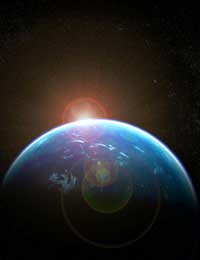The Earth's Atmosphere Explained

Ozone is a vital ingredient in our atmosphere. Without it, mankind and most other life on earth would not exist because it protects us from the sun’s radiation.
However, the amount of ozone in our atmosphere is very small when compared with everything else that’s up there. Oxygen, for example, without which we couldn’t even take a breath.
The atmosphere is divided into several different layers, beginning with the troposphere. This extends to about 10km above the earth which doesn’t sound very high but the world’s biggest mountain, Mount Everest, is less than 9 km high.
The Tropopause
After the troposphere is an area known as the tropopause and above that is the stratosphere. Most larger aircraft fly in the lower part of the stratosphere and it also contains the ozone ‘layer.’The term layer is misleading because there is no actual “layer” of ozone. It is simply one of the gases in the stratosphere and there isn’t even that much of it when you compare it with the other gases out there.
Ozone (03 ) in the stratosphere is measured in parts per million – and although it is vital to our existence, there are only a few parts per million of ozone in the stratosphere – and even less at ground level.
Troposphere Temperature Reduces with Altitude
In the troposphere, we accept the fact that temperature reduces with altitude. For example, most people know that even if it’s warm on the ground, if you climb a mountain you will probably get chilly as you reach the summit. (The fact that many high mountains are snow covered even in warmer weather is a good clue).However, in the 1900s scientists discovered that this doesn’t hold true once you get higher into the atmosphere and beyond the troposphere. In fact, they found that the opposite was true and that higher altitude brought heat rather than cold.
Later, it was discovered that this reversal of conditions was due to concentrated ozone absorbing radiation from the sun.
The Naming of our Atmospheric Layers
Based on their differing thermal qualities and other factors, scientists then named our different atmospheric layers and as science progressed, we were able to establish information about atmosphere even beyond the stratosphere.Above the stratosphere, which is separated from the next layer by the stratopause, temperature again follows the pattern that we have at ground level and begins to grow colder as higher altitudes are reached in the next layer, the mesosphere. Temperatures in the mesosphere can actually be as low as –90 degrees Celsius.
Finally, at the boundary of our atmosphere lies the thermosphere, where the position reverts again to growing warmer with higher altitude. This outermost layer of our atmosphere extends to around 370 miles high and temperatures can exceed 1,500 degrees Celsius.
Outside it All
Outside our atmosphere is an area known as the exosphere which eventually simply merges with space.In addition to providing us with vital components to life such as oxygen and ozone, the atmosphere has other important functions. If you’ve ever seen pictures of the moon, you can’t fail to have spotted that its surface is badly pitted with craters from meteorites which have crashed into the planet.
Our atmosphere, however, gives us protection against most meteors. They burn up as they enter the atmosphere – or at least they suffer a lot of damage. Meteor damage isn’t obvious on earth because our atmosphere creates weather which eventually erases any trace of craters.
Composition of Our Atmosphere
Our atmosphere is composed primarily of nitrogen – which accounts for 78% of the gases present and oxygen, at a rate of 21%. Billions of years ago, our planet was very different. There was no oxygen until bacteria began to create it through photosynthesis and it has taken until now for the amount of oxygen in our atmosphere to reach 21%.The remaining 1% of our atmosphere is made up of water vapour and all other trace gases, including ozone, so you can see that a little ozone goes a long, long way.
In fact, ozone at ground level is actually one of the greenhouses gases that you hear about which are causing Climate Change.








